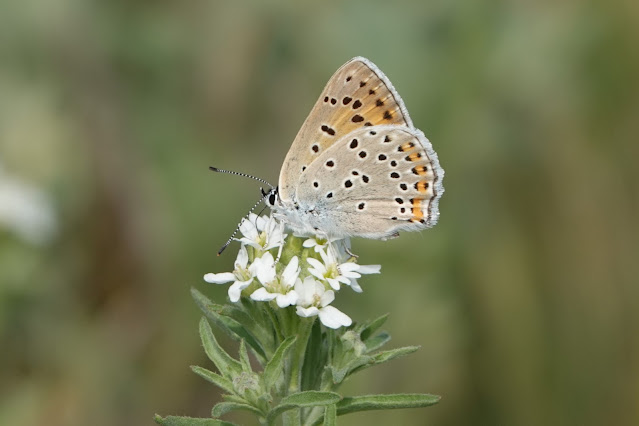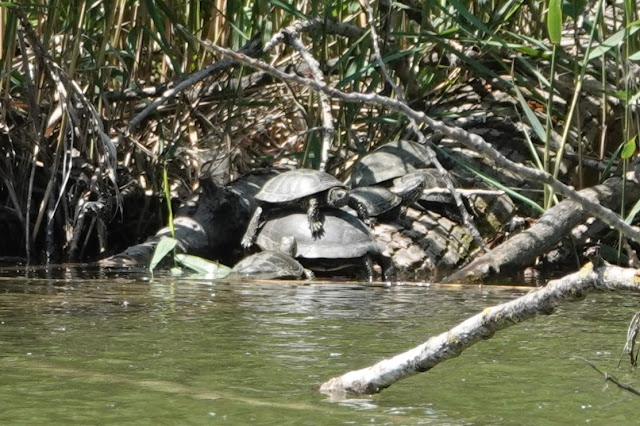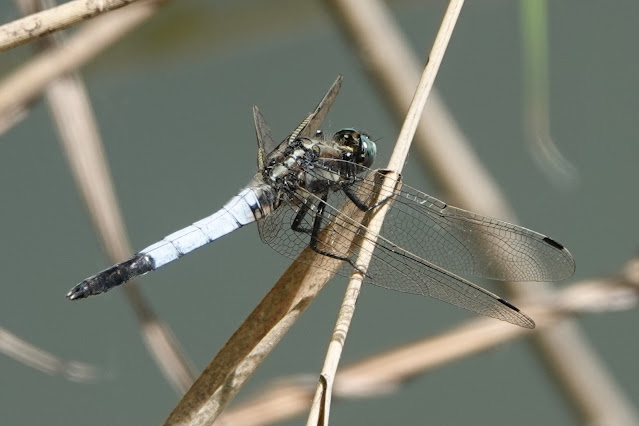8th May:
After a great party I left the girls flat house and walked
the ten miles from Wynchmore Hill to Chingford before persuading Roy to take me
home and what with the Whiskered Tern still being at Abberton we pottered off
there. The weather was quite changeable
but we eventually located this smart adult hawking close in with some Commons.
It Particularly liked perching on a huge dead tree that was floating across the
reservoir. There was not much else to be seen bar a smart Hobby and a huge
number of hirundines.
Hearing that a trip of ten Dotterel were parading around
themselves around a field near Burnham-on-Crouch, we headed down that way. My first for two years and an Essex tick too.
There was no sign of the female Monty’s.
13th May:
A long planned trip with both Adrians saw us down at Drift
Reservoir at dawn. Unfortunately the Squacco could not be found but we were
lucky enough to see the Purple Heron departing not long after we arrived.
With time pressing on we headed to Penzance to catch the
Scillonian III and feeling brave, we all had a hearty breakfast. The crossing was pretty smooth and supplied
us with a few birds every now and then.
Manx Shearwaters were frequent close to the mainland and a few Terns
included a Black in summer plumage but none were being pursued by the stonking
by the fully spooned Pomarine Skua – my first ever in the spring. A Turtle Dove and Storm Petrel were the only
other birds of note and Common Dolphins were noted.
The Scillies looked glorious in the bright sunshine from the
boat as we approached. We still had no
news either way on the Porthloo Squacco and Little Bittern and as the former
had been refound at Cliffe, tensions were a little high. Our taxi driver delighted in telling us that
he himself had seen the Bittern that very morning. Five minutes later we too
were watching this tiny Heron. I had
been hoping for good views but did not expect to see it at just six feet range
and for it to be the size of a milkbottle!
 |
| Little Bittern #402 |
This female bird seemed completely unconcerned about our
excitable presence. She was contentedly
catching tadpoles in this beautifully vegetated ditch and looked dwarfed by
even the Buttercups.
We watched her for ages before I decided to go wandering and
headed for the golf course and then down past Telegraph and Four Lanes before
returning to Porthloo. I saw nothing
but it was a beautiful day and it was just nice to be back on the islands. The
Bittern was still present but the guys were not so I went through Lower
Moors. No Squacco or Night Herons; only some Gadwall and a pair of Pintail while Reed Warblers were an embarrassing
year tick.
I eventually made it round to where we were staying via The
Dump and picked up the others for a walk back to Porthloo where to our delight
the Squacco chose that moment to fly in. A very grey brown individual but still
very smart and equally confiding as the Little Bittern which reappeared under
our noses and in fact we had both in the same scope view at one stage.. A plane came in and the LB flew into the
hedge whirring over our heads in the process.
 |
| Squacco |
 |
| Little Bittern |
Later on we made it down to Porthcressa beach were the 1w
Kumlein’s Gull was easily picked up looking like a standard Iceland but with
dusky wing tips. After this we settled
down for an evening in the Bishop and Wolf but were interrupted mid pool game
by news of a male Subalpine Warbler on Harry’s Walls but it failed to reappear
in the gloom. Not to worry though –
quite a day. [Eds: I neglected to mention that my camera back opened when back I
the digs and I lost a whole film of both heron including some of both together.]
14th May:
I got up early to look for the Subalp before meeting the
others and heading over to Tresco for the Black Duck. A normal and hepatic
Cuckoo flew over the harbour as we boarded the boat. A very white 2w Iceland
Gull flew past as we headed out and a
smart adult Roseate Tern was with the Common, Sandwich and Arctic Terns on the
crossing along with a few Auks. We
landed in high spirits regardless of the imminent rain. The next six hours were
miserable with now renamed Black F**k refusing to show. Ok, it’s not the most
stunning bird in the world but it would have been a tick.
It was not a totally wasted day with a lone Little Egret
adding itself to the Heron list and a fine female Montagu’s Harrier that I saw
twice. The second time she was looking
particularly bedraggled and allowed a close approach in the heather. A small
group of Whimbrel also flew over and feeling soaked through and fairly
despondent, we caught the last boat back to St Marys and hopped onto the
Scillonian. I have no recollection of the journey back to Cornwall of the rest
of the trek back to Essex.
15th May:
The expected lay in did not arrive as Adrian rung me at 8.15
[Eds: must have been on the landline!] to tell me that there was a male
Subalpine Warbler at Walthamstow Marshes and so up I got and off I
trundled. There was quite a crowd
gathered but was proving difficult to pin down despite the occasional burst of
rattling song but eventually he showed very well in a small Hawthorn. A very
bright individual though the pinky red was confined to the upper breast with little
on the flanks [Eds: it was indeed later accepted much later as an Eastern
Subalp].
 |
| Eastern Subalpine Warbler |
A short while after getting home Roy phoned to say that a
male Sardinian Warbler was at Holme in Norfolk so having the chance of seeing
two Med warblers in a day seemed to good to miss especially as Roy needed it
and there was also Lesser Yellowlegs and Great Reed Warbler up there!
I was expecting a long wait for the Sardinian but it only
took five minutes for this very dapper immature male to pop out and parade
about in his chosen Bramble clump.
 |
| Sardinian Warbler |
With time pressing on we headed east towards Cley for the
Lesserlegs. The car park looked full so
we drove past, turned round and headed back at which point we saw it take off
from a small pool near the junction of the Coastguards road! We never saw it again.
As we parked up a superb Osprey cruised over and the local
Avocets and Gulls took exception to it and after a while it headed west and
over Blakeney. Down at the hides the Great Reed Warbler was refusing to sing,
let alone show itself so we had to be content with ha variety of waders which
included two Temminck’s Stints, three Little Stints and a sum plum Curlew
Sandpiper.
With the warbler refusing to croak I headed round to the
North Hide where people were happily stringing Greenshanks as the Lesser
Yellowlegs. Half hour later I was back at Dawkes having missed a fifteen minute
showing by the Great Reed! But he was still busily singing but despite staying
until nearly dark he never came out again.
The Osprey returned in the interim and a pair of Garganey dropped in
right outside the hide with the male giving his curious rattling display calls.
The perfect evening was rounded up by booming Bitterns and reeling Grasshopper
Warblers.
[Eds: not sure what happened in the rest of May! Perhaps I had exams or there were no birds to chase!!]
















.JPG)



















































.JPG)
.JPG)
.JPG)




























